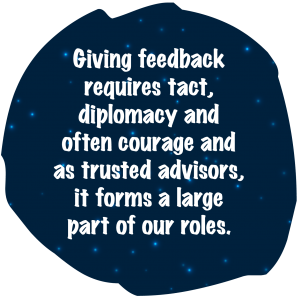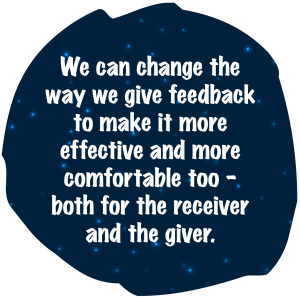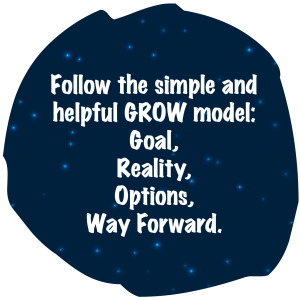As if hearing footsteps behind you on a dark night, the hairs on the back of your neck stand on end. ‘Let me give you some feedback.’
It’s hard to believe these innocent words activate our threat system. But neuroscience confirms what many of us already know: receiving feedback can be uncomfortable. And giving it can be just as bad.
Not only that, feedback is often ineffective. A 1996 study concluded that feedback only improved performance in around one third of cases. In another third it had no impact at all, while in the remainder it led to worse performance.
Yet part of our role as trusted advisors is to give feedback to leaders and line managers on how well they communicate.
And there’s a clear need for this. Less than half of the internal communicators who responded to the Gatehouse State of the Sector survey rated senior leaders’ communication skills above ‘adequate’. Less than a quarter did the same for line managers.

Giving feedback requires tact, diplomacy and often courage. Feedback can help build and strengthen relationships – or it can damage them.
So how do we give feedback effectively? What works, and what doesn’t? And how can we make it less of a threat?
Instructions vs feedback
Sometimes the path to effective performance is crystal clear.
Pilots have pre-flight checklists. Nurses follow prescribed steps for giving an injection. Customer service operatives follow defined scripts. Failing to follow those instructions requires corrective action.
In the same way, an internal communicator would correct a colleague who ignores the house style guide, makes a spelling error or uses the wrong branded template.
But in many cases there is no single ‘right way’ to communicate effectively. Instructions can’t help. But feedback can.
In How to Own the Room, for example, Viv Groskop highlights the diverse communication approach of female leaders from Angela Merkel to Oprah Winfrey to JK Rowling. The common thread? They’ve each built on their natural strengths to become authentic, impactful – though very different – communicators.
Why feedback fails
Many people define feedback as telling people what they think of their performance and how they could do better.
But in their recent Harvard Business Review article The Feedback Fallacy, Marcus Buckingham and Ashley Goodall highlight three reasons why this approach is often ineffective.
1. Studies show we’re consistently poor at rating other people’s performance. This phenomenon – the snappily titled ‘idiosyncratic rater effect’ – means our rating of someone else tends to reflect more our characteristics than theirs.
2. Criticism inhibits our ability to learn. Like those footsteps behind us on a dark night, it activates our ‘fight or flight’ system. This focuses our brain on the information needed to survive, and closes down those areas most receptive to learning.
3. Our view that excellence can be easily defined and transferred from one individual to another is flawed. For example, compare the comedic styles of Ricky Gervais, Jo Brand and Billy Connolly. Each is very different, yet they’re all successful comedians. They’ve built on their strengths to develop their own unique version of excellence.
Three ways to give feedback more effectively
With these pitfalls in mind, we can change the way we give feedback. Not only will this make it more effective, it will make it more comfortable too – both for the receiver and the giver.
 First, focus on someone’s strengths. Research suggests we grow best in areas where we’re already strong. Social researcher Brené Brown recommends we share three observable strengths for every improvement opportunity.
First, focus on someone’s strengths. Research suggests we grow best in areas where we’re already strong. Social researcher Brené Brown recommends we share three observable strengths for every improvement opportunity.
If a leader included a great story or anecdote in their weekly blog, let them know how it made you feel. If they used the rule of three in a presentation, tell them how effective it was. Building on what’s there already is more effective than focusing on what’s missing.
Second, share your reactions of how a person’s behaviour came across to you. This is especially important when feeding back opportunities for improvement. In this way, you’re not judging or rating or fixing someone. You’re simply sharing your personal reflection of how their actions impacted on you.
Changing our language can help. Buckingham and Goodall suggest moving from:
- ‘Can I give you some feedback?’ to ‘Here’s my reaction’
- ‘Here’s where you need to improve’ to ‘Here’s what worked best for me, and why’
- ‘Good job!’ to ‘Here are three things that really worked for me’
Third, help people devise their own improvement actions. You might ask them to evaluate their own performance, or to look for examples in their past experience that will help them tackle current issues.
As Lane4 consultancy director and former Olympian Adrian Moorhouse once wrote: ‘As a swimmer, I had an outstanding coach but he himself could not swim very well at all. That didn’t stop him from leading me to an Olympic Gold Medal. He understood how I operated, my strengths and weaknesses and asked great questions to enable me to come up with the answers for myself.’
How to tie it all together
 Feedback is best given ‘on the spot’ – for example, when giving reactions to a presentation or a draft report. But sometimes a more structured approach is useful. A simple but helpful tool is the GROW model for coaching. This has four steps which you can use at any one-to-one meeting.
Feedback is best given ‘on the spot’ – for example, when giving reactions to a presentation or a draft report. But sometimes a more structured approach is useful. A simple but helpful tool is the GROW model for coaching. This has four steps which you can use at any one-to-one meeting.
- Goal – agree the objective and topic for discussion
- Reality – invite the individual to assess their own performance, and offer specific examples of your own reactions to their performance if relevant
- Options – invite the individual to suggest options for improvement, based on their own experience, and help them to develop alternatives
- Way forward – identify possible obstacles, and commit to actions and next steps.
Feedback doesn’t have to be a threat. So embrace its power and help your leaders, managers and teams to become better communicators. You can find more great tips in Coaching 101: A Guide for Communicators.
by Dave Wraith for Alive!
















